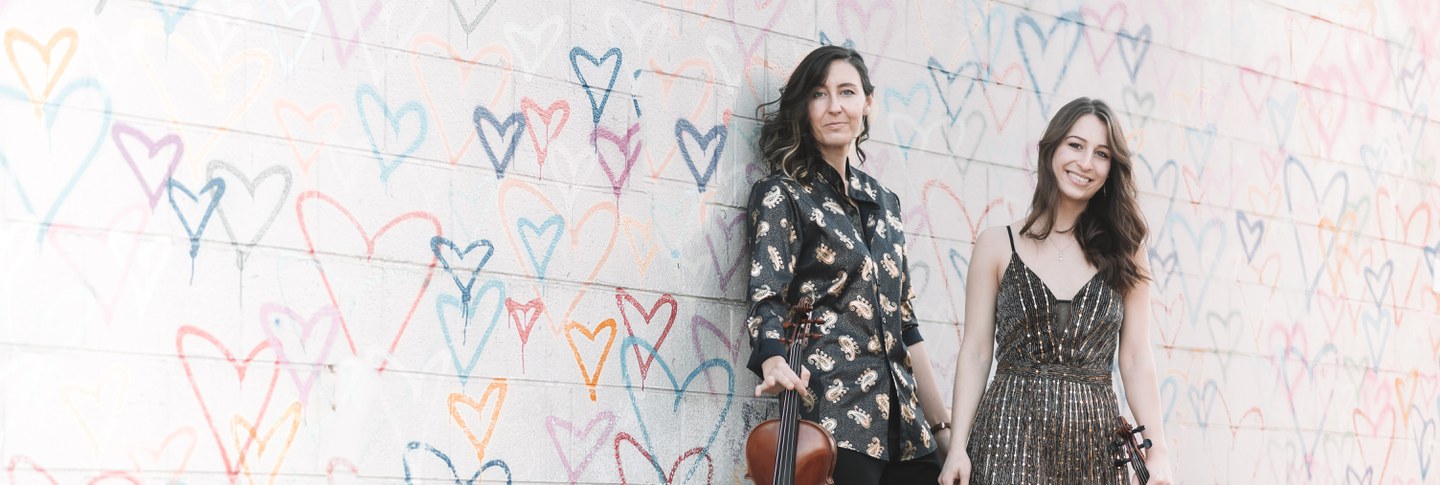Aria Cheregosha and Lauren Spaulding, classically trained violists who perform together as Tallā Rouge Duo, are the 2023–2024 Musicians-in-Residence at Dumbarton Oaks. The scarcity of duets written for two violas has spurred them to arrange and transcribe diverse works that push the boundaries of ensemble playing. These projects, as well as new commissions, will comprise the program for the duo’s Music at Dumbarton Oaks concerts on January 21 and 22, 2024.
What are your key motivations and influences as an ensemble?
Lauren:
We really want to expand the viola duo repertoire available to musicians. Initially, Tallā Rouge was a collaboration over Instagram when Aria was in New York at Juilliard finishing her master's program with Roger Tapping of the Juilliard String Quartet and I was in Colorado. We did some of “Frank Bridge: Lament for Two Violas” (1912), which is one of the best-known viola duos by an English composer. Then the pandemic hit, and Aria moved to Colorado. Since we didn't have anybody else to perform chamber music with, we created a viola duo. Roger Tapping was a huge fan and gave us lots of coaching and helped us create a vision for the ensemble and group sound. One of the first arranging projects for two violas that we did was the Beethoven “Eyeglass Duo,” originally for viola and cello, and we found great success with it and received a lot of interest from Juilliard. That catapulted us forward, and when we ran out of repertoire, we started looking at commissioning and arranging and making transcriptions. Our explorations started to encompass a huge array of global and contemporary musical expressions.
Aria:
My familial heritage from Iran had a huge influence on my musical upbringing, and I was really inspired to establish a meaningful connection there by adapting and performing different Persian and West Asian musical works. Lauren has also been delving into musical traditions related to her Cajun heritage and the world of American sound. We love integrating these compositions and performances together, but we also generally abide by an ethos of “good music is good music” in our programming. Our plan for the upcoming concerts is to embody this mix of personal and broad resonances. Two works we commissioned—"Seesaw" by Karl Mitze and "Navazi" by Kian Ravaei—are going to have their world premieres.
Lauren:
Mitze’s writing style is exciting for a viola duo. Not only does it feel great in our hands, but it’s also really well-structured, highly engaging, and very accessible. We’ll start our program with that. We also wanted to find someone who shared Aria’s experience of living in America and knowing the traditions of Iran but never having been able to go experience them. And so Ravaei, a Persian American composer, is a great fit for us. The piece is four succinct movements intended to be dispersed throughout a program. It’s inspired by the kamancheh, which is a traditional Iranian string instrument. While one of us plays a drone, the other plays the kamancheh part and we switch back and forth. It’s sort of like a solo work with a flavor of other voicing that’s quite interesting.
What does the viola duo as a medium offer to today’s classical music landscape?
Lauren:
We’re trying to make the viola duo a concertizing ensemble that you could see on any major roster. We will never fit in the canon of classical music. We have such limited repertoire that is traditionally classical: we have Stamitz, we have Beethoven, we have a couple of options. But where we actually seem to fit a bit better is along the lines of quartets that are performing very modern works. There’s a bit of a shiny, “what the heck” factor to us. I think the vision is to add and to curate the experience around what two violas can do. Violas are traditionally seen as the underdog in many ways, so putting violas in the spotlight is really interesting. Our vision for the future is something like Tallā Rouge and Friends, which would include voice and viola duo. The viola and kamancheh duo would be incredible. We’d also love to do quintets or sextets, having people join in after introducing the audience to the viola, as in, here’s what violas can do and here’s what two violas playing together can do when you put them in an ensemble. That feels like a fun, creative path for us to explore in the future.
How has the scholarly community of Dumbarton Oaks influenced your projects?
Aria:
Dumbarton Oaks is an incredibly unique opportunity in the music world, maybe any world, to have space and time, resources, and a lot of intelligent voices and colleagues who are diving into the research that we've been doing. We’ve had so much time to create new arrangements and commissions. I think both of us probably work sometimes six to eight hours a day, just rearranging new works or working with composers. We do a lot of Zoom meetings where we're editing the works and making sure that everything feels idiomatic in our hand. Plus, it is not all that often that musicians get to deeply engage with experts who specialize in nonmusical subjects, so the chance to acquire knowledge from these various fields of study on a regular basis has been unique and invaluable.
Lauren:
One thing I’ve found really interesting is talking especially with scholars of Armenian studies here, discussing the architecture and how sound is experienced in those buildings. Even just having colleagues come sit on my couch and listen to new arrangements and get their feedback is invaluable, as the majority of people we play for are mostly general audience members looking for a moment of reflection, looking for an experience or a joyful moment. So, what very intelligent colleagues have to say about the music—for instance, whether it felt too fast or it really moved—those things are really important for us to hear.
Amelia Roth-Dishy is a 2023–2024 Dumbarton Oaks Humanities Fellow.

